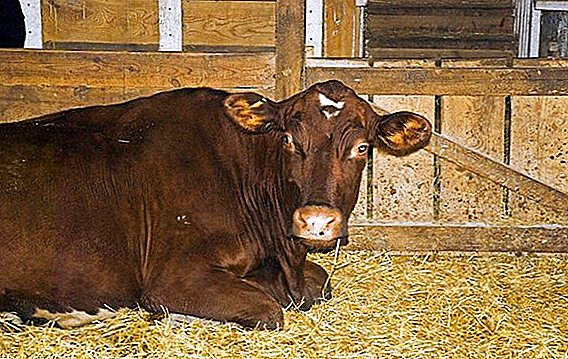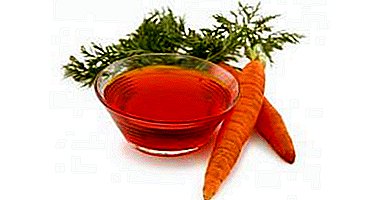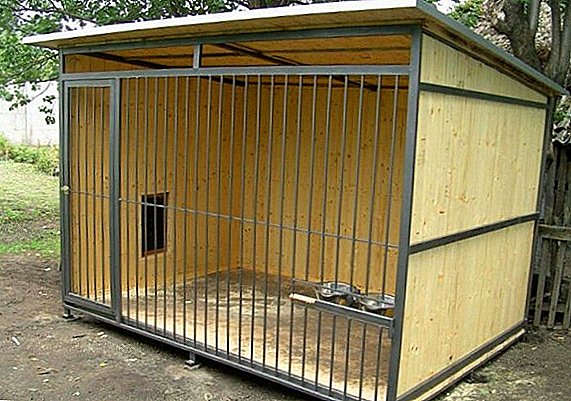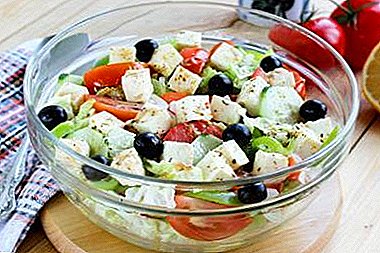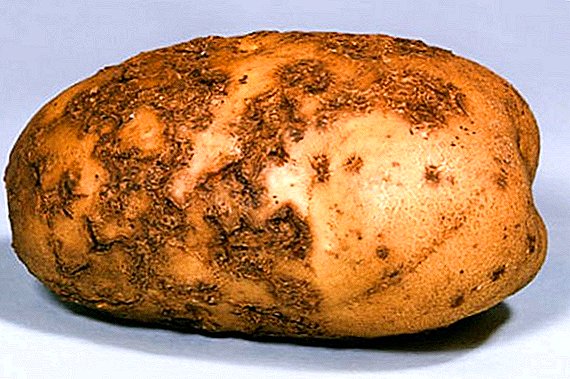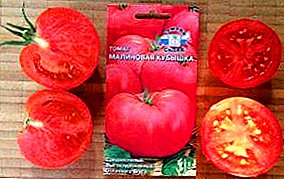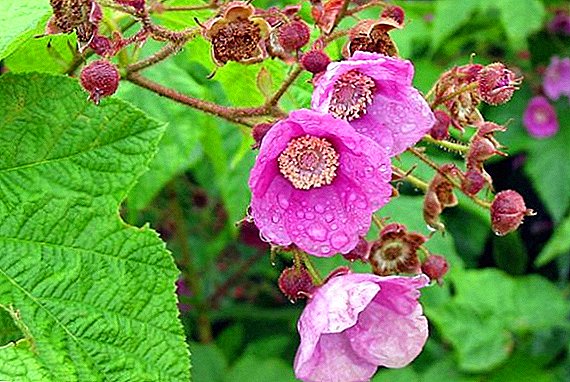
Careful care of your "pets" plants will help you pass the time, fill life with new colors. Cyclamen is one of the plants whose home care will brighten up everyday life.
In our article you will learn in detail all the nuances of growing this flower: how to water and replant it, how to propagate it, what it needs for proper growth and flowering. You can also watch a useful and interesting video on this topic.
Botanical description of the flower
Cyclamen (or, as it is also called, "Alpine violet") is a very beautiful flower. It is a herbaceous plant with heart-shaped leaves and bright flowers. Alpine violet reaches a height of 30 centimeters in height, a round tuber with a diameter of 10 to 15 and more centimeters "sits" underground.
One of the most popular representatives is the Persian cyclamen. Its flowers can be of various colors and shades:
- whites;
- pink
- dark red;
- lilac.
Description and photos of the most beautiful varieties of cyclamen, as well as tips on caring for them, can be found in a separate article.
How to grow at home?
 If you decide to take up the cultivation of this flower, you need to consider the following. In the room where you will plant the plant, it is necessary to comply with certain conditions, as the flower is whimsical with respect to temperature. The air temperature where cyclamen "quarters" should be in the range of 10 to 20 degrees Celsius. In a place where there is a flower pot, there should not be strong drafts. Indoor air must be humidified (humidity level - at least 85 - 90 percent). It is undesirable to place cyclamen in close proximity to radiators.
If you decide to take up the cultivation of this flower, you need to consider the following. In the room where you will plant the plant, it is necessary to comply with certain conditions, as the flower is whimsical with respect to temperature. The air temperature where cyclamen "quarters" should be in the range of 10 to 20 degrees Celsius. In a place where there is a flower pot, there should not be strong drafts. Indoor air must be humidified (humidity level - at least 85 - 90 percent). It is undesirable to place cyclamen in close proximity to radiators.
In order to grow a home flower, it is necessary to avoid direct sunlight, since cyclamen loves diffused light. Otherwise, your "pet" may wither. If you decide to plant a cyclamen in the country, choose a place in the shade of large plants.
It is necessary to water this plant only through the pallet. Water should not fall on the plant. For the same reason, avoid spraying it.
Before you grow this flower at home, you need to choose the right soil. The ideal soil composition for cyclamen is as follows:
- peat;
- sand (preferably coarse);
- leafy humus;
- clay;
- vermiculite
However, it will also suit the purchase of soil for cacti. Make feeding is recommended only during active growth of the plant., about 1 time in 2 weeks.
Watch the video about the characteristics of growing cyclamen at home:
Breeding methods
Below is a description of how to dissolve cyclamen.
Seeds
For sowing seeds:
- Take a shallow but wide capacity.
- In the ground, poured into a container, make a small groove, a little water the soil.
- Plant seeds approximately at a distance of 3 centimeters from one another.
- Top the seeds covered with earth.
- Place the container in a shaded place, water more often, not allowing the soil to dry.
The best temperature for cyclamen shoot - 18 degrees. It is necessary to avoid overheating of saplings.
Watch a video about growing cyclamen from seeds:
With sockets
Reproduction rosettes (or otherwise "horns") is as follows:
 Shoots on cyclamen tubers (which are called "horns"), tear off and land in moist soil.
Shoots on cyclamen tubers (which are called "horns"), tear off and land in moist soil.- The flower itself after such an operation is placed for some time in a plastic bag so that it can recover from the injuries caused to it.
- The roots of the "horn" will appear approximately 2-3 weeks after separation from the tuber.
- The temperature is recommended to maintain at the level of 20 - 22 degrees.
Leaf
Another breeding method - cut leaves. To do this, the leaves, separated from the "mother plant", are planted in moist soil, where they take root.
Board: However, this method is not suitable for all types of cyclamen. For example, leaves of European cyclamen root very rarely, so using this method is not recommended.
Diseases and pests
A few words about the diseases and pests affecting cyclamen. These include:
- Mealy dew. External symptom - plaque on the upper part of the leaves of the diseased plant, their darkening.
- Fusarium and Verticillus. In the presence of such a disease, the rhizome and base of peduncles are painted in an intense brown color.
- Phytophthora. Its symptoms are sweat pigmentation on all parts of the plant, stalk pus.
- Gray rot. Leaves and shoots are covered with a gray bloom.
It is possible to prevent infection with these diseases by regularly airing the room where the plant lives. But beware of drafts, they can easily kill cyclamen.
Vulnerable flower for pests. Among them:
- spider mite;
- whitefly;
- aphid;
- schitovka.
You can get rid of them by gently washing the plant in a soapy solution, or by applying an insecticide.
Care rules
Cyclamen does not like drafts, but stagnant air is also harmful to it.. Therefore, it is best to place this plant on a window facing the south or southeast, and which rarely opens.
Watering
 Cyclamen loves the "middle ground" - too wet soil, like overdried, will be harmful to it. Water the flower should, when the soil in which it grows, to the depth of the phalanx of the finger becomes dry.
Cyclamen loves the "middle ground" - too wet soil, like overdried, will be harmful to it. Water the flower should, when the soil in which it grows, to the depth of the phalanx of the finger becomes dry.
Spraying the plant is also not recommended. Also, experienced growers are advised to replant cyclamen at least 1 time per year - its root system needs room for growth.
It is recommended to water the plant only with separated, not boiled water.. For sludge, water is poured into a container with a wide neck (a basin is best suited) and kept for 6-8 hours.
Moreover, for irrigation should take only the top layer of water, since all harmful substances settle at the bottom of the tank. It is not recommended to use boiled water for irrigation.
Fertilizers
Fertilizers for flowering plants will be the ideal flower feed.. But it is not recommended to use mineral fertilizers for feeding cyclamen. Ooi can harm the flower.
Also, in the pot, where your pet lives, besides the soil, it is necessary to add a drainage layer. For this purpose, suitable gravel or expanded clay.
Transfer
Another important aspect of cyclamen care is its transplant.. As already noted, it should be carried out about 1 time per year. When transplanting be careful - there is a high risk of damaging the delicate roots of the plant.
The deadline for transplantation is from about the end of July to August, when the plant leaves the dormant period and prepares for flowering. Signal to transplant - the formation of new young leaves.
 Before transplanting the soil mixture in which you plan to plant cyclamen, it is recommended to ignite in the oven - this will destroy all possible pests. The pot is also recommended to be disinfected with a solution of potassium permanganate, or other available means.
Before transplanting the soil mixture in which you plan to plant cyclamen, it is recommended to ignite in the oven - this will destroy all possible pests. The pot is also recommended to be disinfected with a solution of potassium permanganate, or other available means.- Further, all dry and damaged leaves are removed from the plant, and dry or rotten roots are cut. After that, the old soil is completely removed from the roots, the cyclamen is placed in a new pot and its root system is covered with earth.
- It is not recommended to plant the plant immediately in a large container. Excessive volume of soil can lead to rotting of the roots, as well as to the fact that cyclamen refuses to blossom - all its forces will go to the formation of excess root system.
- After the transplantation is over, it is recommended that the plant be watered slightly warm (the temperature is 5-7 degrees higher than the air temperature) and separated by water.
After transplantation, cyclamen requires especially careful care.. Otherwise, he may not settle down on the "new place" and die!
Watch the video about the correct transplantation of cyclamen:
Conclusion
Cyclamen is one of the most beautiful indoor flowers and rightfully deserves first place in the collections of amateur growers. He is able to add new colors both to the apartment and to the office space, to bring notes of cheerfulness and optimism into everyday life.
Having provided the proper care for cyclamen at home, you can rightly be proud of your handsome man, and he, in turn, will delight you with his annual flowering.


 Shoots on cyclamen tubers (which are called "horns"), tear off and land in moist soil.
Shoots on cyclamen tubers (which are called "horns"), tear off and land in moist soil. Before transplanting the soil mixture in which you plan to plant cyclamen, it is recommended to ignite in the oven - this will destroy all possible pests. The pot is also recommended to be disinfected with a solution of potassium permanganate, or other available means.
Before transplanting the soil mixture in which you plan to plant cyclamen, it is recommended to ignite in the oven - this will destroy all possible pests. The pot is also recommended to be disinfected with a solution of potassium permanganate, or other available means.